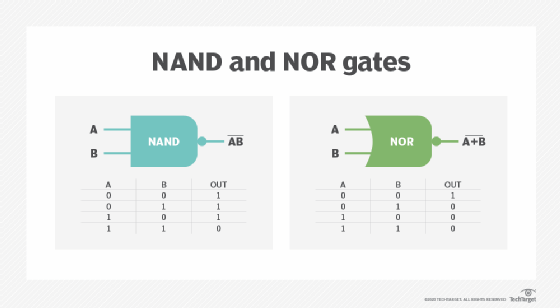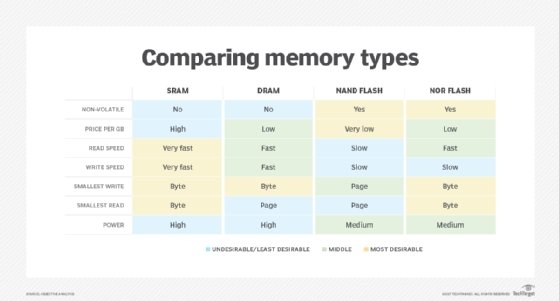
NOR flash memory
What is NOR flash memory?
NOR flash memory is one of two types of non-volatile storage technologies. NAND is the other. Non-volatile memory doesn't require power to retain data.
NOR and NAND use different logic gates -- the fundamental building block of digital circuits -- in each memory cell to map data. Both types of flash memory were invented by Toshiba, but commercial NOR flash memory was first introduced by Intel in 1988. NAND flash was introduced by Toshiba in 1989.
NOR flash vs. NAND flash
NOR flash is faster to read than NAND flash, but it's also more expensive and it takes longer to erase and write new data. NAND has a higher memory capacity than NOR.
NAND memory devices are accessed serially, using the same eight pins to transmit control, address and data information. NAND can write to a single memory address, doing so at eight bits -- one byte -- at a time.
In contrast, older, parallel NOR flash technology supports one-byte random access. This enables machine instructions to be retrieved and run directly from the chip -- in the same way a traditional computer retrieves instructions directly from main memory. However, NOR must write in larger chunks of data at a time than NAND. Parallel NOR flash has a static random-access memory (SRAM) interface that includes enough address pins to map the entire chip, enabling access to every byte stored within it.
NOR flash technology is also more expensive to produce and has a higher cost per bit than NAND. That, and its random-access function, mean NOR is mostly used for code execution, while NAND flash memory is mostly used for data storage.
When it comes to power consumption, NOR flash memory requires a higher power current than NAND when it is first powered on. However, once powered on, the standby power requirement for NOR is much lower than NAND. Therefore, NOR is generally better for random reads from memory, whereas NAND is more efficient at writes, erases and sequential reads.

NOR flash is most often used in mobile phones, scientific instruments and medical devices. NAND has found a market in devices to which large files are frequently uploaded and replaced, such as MP3 players, digital cameras and USB (Universal Serial Bus) flash drives.
Some devices use both NAND and NOR flash. A smartphone or tablet, for instance, might use embedded NOR to boot up the operating system (OS) and a removable NAND card for all its other memory or storage requirements.
What are the benefits of NOR Flash?
The primary benefit to using NOR is that it delivers far better read performance than a comparable NAND device. By way of comparison, a NAND multi-level cell (MLC) flash device can be expected to read data at about 20.5 MBps (megabytes per second), while comparable NOR MLC flash devices have benchmarked read rates of 61.5 MBps.
At the same time though, NOR's write and erase operations are much slower than NAND storage. A NAND MLC device might write data at 3.2 MBps, while a comparable NOR MLC device is only able to write data at about 0.47 MBps. Additionally, the size of its individual cells limit overall storage capacity.
NOR's limitations combined with the fact that NOR delivers blazing-fast read performance means NOR is best suited to use cases in which a limited amount of data needs to be stored and in which most of the storage IO (input/output) will be read IOPS (I/O per second).
This is why NOR flash is so commonly used in consumer devices such as tablets and smartphones. Those devices tend to have relatively lightweight OSes that can easily fit within NOR's limited capacity. NOR's characteristically fast read performance enables the OS to be booted far more quickly than would be possible if the device's OS were stored on NAND storage.

Mobile OSes tend not to be write-intensive, which also makes NOR a good fit. However, because NOR flash cells exhibit comparatively poor write performance, it can lead to slow OS updates.
NOR is also an excellent choice for use in embedded systems, because these systems tend to read code during the boot process but perform few, if any, write operations.
Major vendors and products
According to a 2023 report by Industry Research, the top NOR flash manufacturers are Cypress, Eon, GigaDevice, ISSI, Macronix, Microchip, Micron, Samsung and Winbond.
The global NOR flash market was estimated at $3.30 billion in 2022 and is forecast to hit $3.37 billion by 2029, the report said.
Among those, Cypress Semiconductor also supplies embedded system components that use NOR flash memory for industries such as automotive and the internet of things (IoT). In comparison, Micron Technologies is mainly known as a supplier of flash chips -- both NOR and NAND -- as well as dynamic RAM (DRAM) to component manufacturers.
Serial NOR
There are two main types of NOR memory chips: parallel NOR and serial NOR. One of the main things that differentiate serial NOR from parallel NOR, is that serial flash devices require fewer connections to the circuit board than parallel flash devices do. The fact that serial NOR uses a less complex interface than parallel NOR means that it costs less to manufacture serial NOR storage devices.
SPI NOR flash memory chips are organized into sectors and pages. A sector is defined as the smallest erasable block size. Sectors can be subdivided into pages. Data can be written in page-size chunks, even though pages tend to be far smaller than sectors. By way of comparison, sectors are usually measured in kilobytes (KB), with 4, 32, 64 and 256 KB being common sector sizes. Conversely, page sizes tend to be measured in bytes, with 256 and 512 bytes being common page sizes.
The way that data is written to an SPI NOR device varies depending on whether the memory chip is equipped with a buffer. If the serial flash memory is buffered, then a page can be read into the buffer, modified and written back to the chip. If the SPI NOR device isn't buffered, then the entire page has to be externally read, modified and written back to the chip. As such, buffered SPI NOR tends to have better write performance than comparable non-buffered flash.






